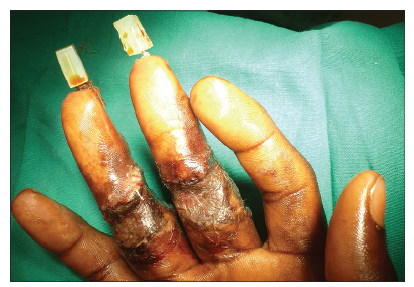Unburied K-wire induced injuries: taking the edge off
Sir,
Unburied K-wires left projecting from the fingers after hand surgery can lead to inadvertent injuries if left open, especially in children or disoriented patients, particularly at the time of reversal of anesthesia and in the immediate postoperative period. Different ways have been described to circumvent this. Many surgeons twist the K-wire on itself along with capping of the wire tip, but this requires considerable twisting force on an already inserted K-wire, which can lead to malalignment or even refracture.[1] Furthermore, the bent K-wire acts like a hook, catching onto dressing materials or clothes and subsequently may migrate out.
We present a simple and effective way of preventing such mishaps caused by unburied K-wire ends using silicone blocks. Silicone blocks are routinely used in procedures like dorsal nasal augmentation and interpositional arthroplasty for temporomandibular joint ankylosis.[2] A small cuboid of silicone block is obtained from a solid silicone block or from a left-over silicone block after sculpting for other indications. The block is approximately 0.5 cm × 0.5 cm × 1.5 cm in size and is inserted gently and with constant pressure over the K-wire end.
The silicone block fits snugly over the K-wire and in our experience spontaneous expulsion of the block from the K-wire tip has not occurred [Figure 1]. The chance of the deeper migration is also minimized.
Sterilization of the silicone block is not essential but is desired, especially in the case of left-over blocks. Capping of the K-wire can be done as the last step of hand surgery after dressing. However in procedures where further operative steps are needed following K-wiring, sterilization of the silicone is a must. This can be planned preoperatively. Our theatre nurse routinely makes a sterilized block of silicone available in all hand surgery cases where K-wiring is needed.
The semi-rigid consistency of the silicone minimizes chances of penetrating injuries to the patient or caretakers. However, patients are counseled regarding proper precautions to prevent inadvertent injuries due to long silicone blocks. Being inert, there is less chance of allergenicity as well. One major advantage is the availability of silicone blocks in most operation theatres.
Silicone block capping is a simple and effective way of preventing injury due to unburied K-wire tip.
Financial support and sponsorship
Nil.
Conficts of interest
None declared.
REFERENCES
1. Nicolaou M, Fleming A. A simple and cost-effective method of protecting unburied K-wire ends. Ann R Coll Surg Engl 2009;91:714-5.
Cite This Article
Export citation file: BibTeX | RIS
OAE Style
Chittoria RK, Mohapatra DP, Thiruvoth FM, Kumar D, Asokan A, Vijayaraghavan N. Unburied K-wire induced injuries: taking the edge off. Plast Aesthet Res 2014;1:121. http://dx.doi.org/10.4103/2347-9264.143561
AMA Style
Chittoria RK, Mohapatra DP, Thiruvoth FM, Kumar D, Asokan A, Vijayaraghavan N. Unburied K-wire induced injuries: taking the edge off. Plastic and Aesthetic Research. 2014; 1: 121. http://dx.doi.org/10.4103/2347-9264.143561
Chicago/Turabian Style
Chittoria, Ravi Kumar, Devi Prasad Mohapatra, Friji Meethale Thiruvoth, Dinesh Kumar, Arjun Asokan, Nandhagopal Vijayaraghavan. 2014. "Unburied K-wire induced injuries: taking the edge off" Plastic and Aesthetic Research. 1: 121. http://dx.doi.org/10.4103/2347-9264.143561
ACS Style
Chittoria, RK.; Mohapatra DP.; Thiruvoth FM.; Kumar D.; Asokan A.; Vijayaraghavan N. Unburied K-wire induced injuries: taking the edge off. Plast. Aesthet. Res. 2014, 1, 121. http://dx.doi.org/10.4103/2347-9264.143561
About This Article
Copyright
Data & Comments
Data

 Cite This Article 0 clicks
Cite This Article 0 clicks











Comments
Comments must be written in English. Spam, offensive content, impersonation, and private information will not be permitted. If any comment is reported and identified as inappropriate content by OAE staff, the comment will be removed without notice. If you have any queries or need any help, please contact us at support@oaepublish.com.